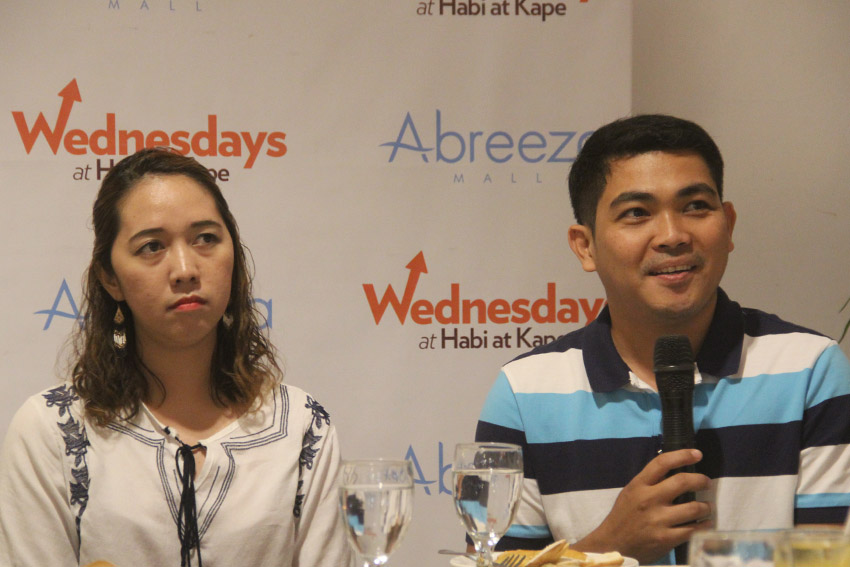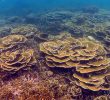
BIOLOGISTS. (L-R) Analyn Cabras and Milton Medina, both Biology researchers from University of Mindanao, present to the media Wednesday the newly-discovered species of flower plant, Hoya reyesii and a beetle, Pachyrhynchus from the mountain areas of Bukidnon and Davao City, respectively. (Earl O. Condeza/davaotoday.com)
DAVAO CITY, Philippines—Two biology researchers from the University of Mindanao wanted a “critical habitat” in order to preserve the newly-discovered species.
UM’s Norman D. Medina, director for Qualitative Studies of the University of Mindanao and Analyn A. Cabras, a biodiversity researcher at UM presented at Wednesday’s “Habe at Kape” two new species— a flower plant and a beetle.
The new species were Hoya reyesii, found in Valencia Bukidnon, and Pachyrhynchus miltoni, found in Barangay Baganihan, Marilog District, Davao City.
The UM researchers said the declaration of the species’ habitat as “critical areas” would require collaborative efforts from the local and national government.
“We could hopefully establish critical habitat for this species where we could preserve one area reserved for researches and will not be developed,” Medina said.
Medina, however, said the increasing human population around the habitat of the species could be a problem. “Most villagers do not know the importance of the plant, they treated it like grass.”
Cabras, for her part, said that in order to establish a critical habitat for the species, it requires a sort of legal processes that must be followed.
With this, they proposed to present their research to the Sanguniang Bayan and develop a map to establish a Geographic Information System.
“There would be a decision [from the City Council] hopefully that this would be established to be critical habitat,” Cabras said.
The Hoya reyesii presented by Medina was actually a discovery of Dr. Ricardo Reyes, a botanist in Bukidnon in 2014. Medina said it took them three months to compare the said plant with other existing Hoyas.
“What we did with the species was lethal examination of there vegetative and reproductive parts to confirm if it was a new species,” Medina said.
“We compare with the existing species all over the world so that we do examination for approximately three months and submitted to scientific community all over the globe.”
Medina said they received the confirmation that Hoya reyesii was a new species just December 2016.
Meanwhile, Cabras described the Pachyrhynchus miltoni “the most beautiful beetle in the world.”
Also considered as another diverse species, weevils have 51,000 different kinds and they differ from beetles because of their long snout.
“It is very interesting because 90 percent of this species are found here in the Philippines and nowhere else in the world,” Cabras said. “It is highly restricted in mountainous and forested area.”
This weevil, according to Cabras, is one of the endemic species in the country as it is mostly being poached and sold to other countries.
Threats of extinction
The two newly-discovered species of weevils and hoya were said to be threatened if they will be taken for granted. Hoya reyesii, which is a plant close to the family of orchids would be affecting the food chain once removed from its habitat.
“If we take on of this, there is an imbalance, this would cut the food chain, and so on,” Medina said. Just like orchids, the Hoya reyesii is a moisture plant which get its liquid from the moisture in the air.
“If there is a good moisture, this plant would thrive,” Medina said. “Butterflies and moth depends on this plant, if we extinct this one, the food chain will be affected.”
The Pachyrhynchus miltoni, on the other hand, could not thrive in places where kaingin takes place or where fruit trees like cacao, are planted.
Because of its characteristic, the said beetle is ” highly poached” and being sold to other countries for about P500 to P5,000 per specimen.
“It is very prone to poaching and be sent to different countries,” Cabras said.
The endemic character of the said beetle is also one of the threat ” that it would become extinct, with no other record where it is found but only in Marilog.”
“No record except Marilog. If their population in Marilog will get extinct, we could not find it anywhere else,” Cabras said.
Cabras said they are hoping for the Department of Environment and Natural Resources would be strict on poaching of the beetle.
Education drive
The UM researchers said they will also have to bring their discovery to a biodiversity research project. The research will take two years to document the biodiversity in the urban and sub-urban areas in the city.
“The project is very simple. To document biodiversity, translate the data to instruction materials and use to educate students on biodiversity,” Medina said.
The project will start this month, but they will still wait for their funds from the Commission on Higher Education to be released.
Once the budget is available, sampling will immediately start of different species in different areas in the city .
The output will be contained in the books to be produced for the purpose. There will also be brochures and pamphlets, about biodiversity.
“[It will be] different information and education materials that would educate the high school and college students about biodiversity and of course will be going to different schools in Davao city to disseminate the information,” Cabras said.
The two-year project is headed by the UM, and in collaboration with San Pedro College, DENR, and Davao Oriental State College. (davaotoday.com)









